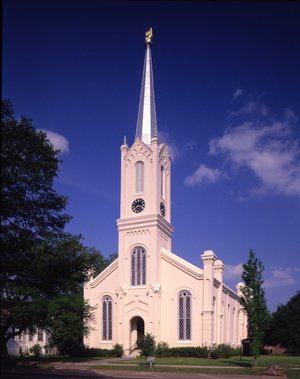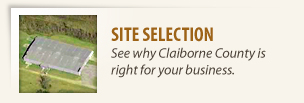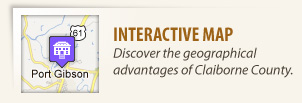
Tourism: Historic Houses of Worship
Church Street is aptly named.
Call it truth in advertising. Although the street was initially called Cotton, what grew up here were churches, eight of them today, in a range of denominations and architectural styles.
First Presbyterian Church (c.1859.) The creation atop the steeple—a gilded hand, finger pointing heavenward—has made this a unique state landmark since its construction. The congregation was organized in 1807 in Bayou Pierre, and its first regular minister, the charismatic Zebulon Butler, had a habit of punctuating his pastoral points with that pointed forefinger. When the church built its new home on Church Street just before the Civil War, the original hand was carved out of wood by local artist Daniel Foley, but when the wood became worn in early 1900′s, the metal replacement was created. Inside the church are two chandeliers from the old steamboat racer, the Robert E. Lee.
Bethel Church (c. 1845) Built around 1845, the Bethel Presbyterian Church played an important part in spreading Presbyterianism into this part of the state, but on the afternoon of April 30, 1863, the sanctuary was a bystander as the Union vanguard passed through after landing at Bruinsburg. Some sources have reported that Union soldiers took shots at the church steeple, but there’s no evidence today, since a tornado took the entire steeple in 1943. The church’s slave gallery has also been removed. Although the church has lost some of its parts, the sanctuary’s exterior still retains its classical Greek Revival symmetry, and the interior is simple and spare. The church is open daily.
St. Joseph Catholic Church (c. 1849.) The oldest surviving church in Port Gibson is a popular stop for visitors, thanks to altar paintings by Thomas Healy and alter rails hand carved by Daniel Foley. The church is open for visits Monday to Friday, 8:00 a.m. to 4:00 p.m. Admission is free.
St. Peter’s A.M.E. Church (c.1870.) Although the original weatherboards and octagonal spire have been replaced by brick facing, the simplified interpretation of High Victorian Gothic makes for an elegant architectural and spiritual statement. Viewing by appointment only.
Christian Chapel Church – Although this structure was built in 1974, the Church’s congregation established in 1845.
Temple Gemiluth Chassed (c. 1891.) This beautiful Moorish Revival structure is the oldest Jewish Synagogue in the state and the only surviving building of Moorish style in Mississippi. By appointment only. The Jewish Community began to arrive in Port Gibson in the 1840’s from Germany and France and became successful merchants. The Jewish Cemetery, the Bernheimer House, and Drake Hill neighborhood are other examples of Jewish heritage in Port Gibson.
Port Gibson Baptist Church (c. 1923.) The highlight of these two brick structures are the Doric columns that support the second story porch. Although the structure is relative newcomer to the street, the congregation was organized in 1872.
St. James Episcopal Church (c. 1884) Designed by noted Boston architect W.O. Wentworth along Victorian lines with a steeple belfry, the church cost $5,000 to build. St. James’ congregation was organized in 1826.
Port Gibson Methodist Church (c. 1860) When the former church burned on this site in 1858, this Romanesque Revival church was built in its place. The congregation was organized in 1804.
First Baptist Missionary Church, 501 Farmer Street, was the spiritual and strategic headquarters for the Civil Rights movement in Claiborne County during the 1960's and 1970's.




